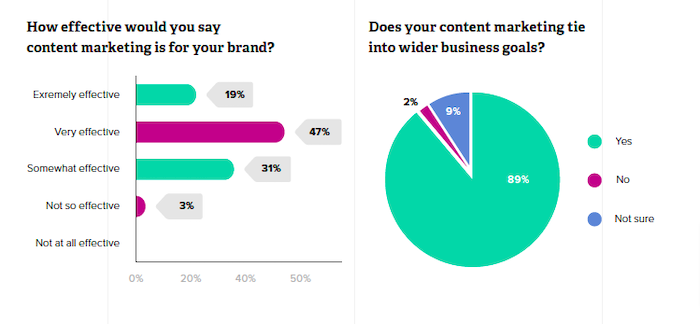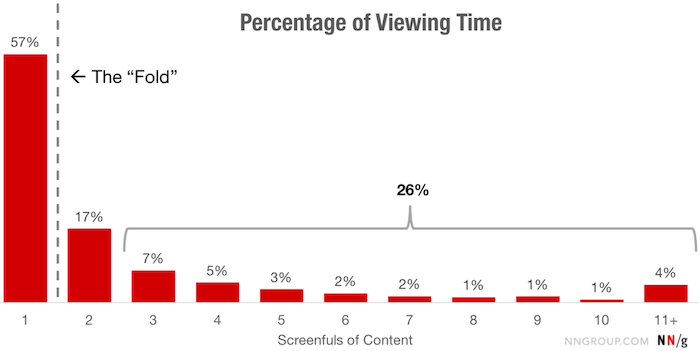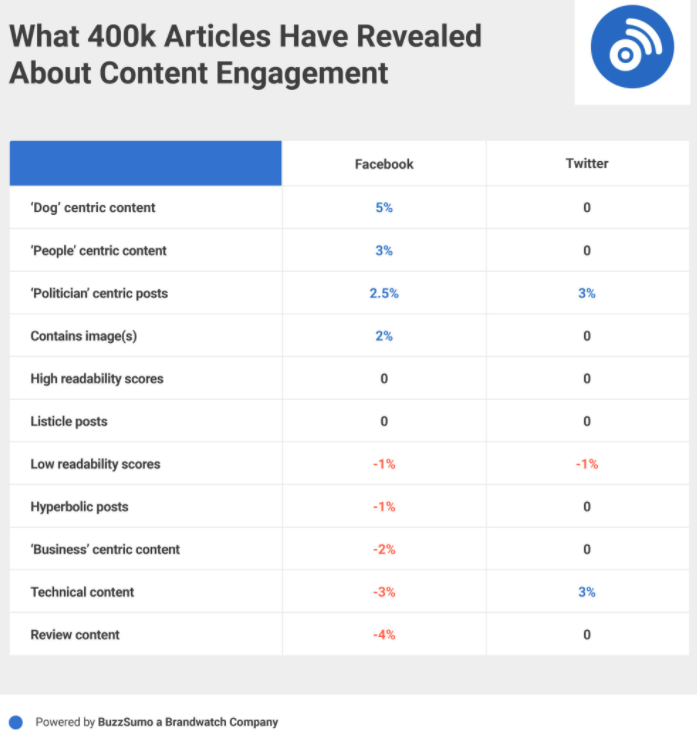
Content writing can be difficult.
Just consider these numbers. An astonishing 98 percent of all marketing teams say written content is their most-used content type, yet one in three marketers admit their content writing is only “somewhat” or “not so” effective.

In other words, there’s a whole lot of content out there that isn’t doing what it should be.
This article aims to help you and your team improve your content writing quality and success levels.
Fortunately, content writing is something people can get better at with a little bit of study and practice. Below you can find the 10 ingredients of great content writing to help you improve.
1. Craft a Compelling Headline
Say you get 100 people to visit your blog. On average, 80 of them will read your headline copy, but only 20 will read the rest.
In other words, your headlines have a lot of heavy lifting to do.
Strong headlines provide specific information and give a little detail to draw people in but stop short of telling the whole story.
We can see how this looks in practice thanks to a BuzzSumo analysis of 100 million headlines on Facebook and Twitter. It found approximately 65 characters (about 11 words) is the sweet spot for headline length.

Of course, it’s not just about the length of your headline. The words are important, too.
Headlines containing instructional phrases like “you need to know” and “why you should” are most likely to be shared on Facebook.

People often want to read content that teaches them something, whether it’s how to improve content writing or a rundown of the hottest draft prospects in Major League Baseball.
2. Hook Readers With an Interesting Intro
Your headline compelled a reader to click on your content. Now you need to persuade them to read on.
That’s easier said than done. According to Nielsen Norman Group, approximately 57 percent of page-viewing time is spent above the fold, before readers need to scroll. For the second screenful of content, that figure plummets to just 17 percent, and only the most dedicated make it much further.

In other words, if your intro doesn’t immediately grab your readers’ attention, don’t expect them to stick around.
The best way to keep your audience reading is by jumping straight into the content promised by your headline.
For instance, if you’re reading this article, it’s a fair bet you want to write better content. So, in the introduction, I acknowledged your challenge and explained this article is here to help you find a solution.
Presumably, that intro worked because you’re still reading!
3. Write for Your Audience
A snappy introduction may help you keep your readers’ attention for longer, but it’s not a silver bullet. You need to write with your specific audience in mind.
Or, to put it another way, write for a small subset of people, not for everyone.
To give a simple example, it’s like the difference between an article on “great content writing” and one on “great writing.”
Because you’re searching for tips on content writing, I can make informed guesses about you. For instance, chances are you work in marketing or are creating marketing-related content.
On the other hand, if this was an article on “great writing,” you could be anyone from a student to a novelist struggling with writer’s block. If I tried to write for all those possible audiences, I’d likely not hit the mark for any of them.
4. Narrow Your Article’s Focus
Each article should have a single clear idea from headline to conclusion.
Following this approach can help you form more logical arguments, write copy that flows naturally, and provide your readers with clear takeaways.
Unless you’re writing a pillar page acting as a central point for discussing a broad topic, keep your focus as tight as possible. For instance:
- Bad: How to improve your marketing
- Better: How to do better small business marketing
- Best: How to do social media marketing for SaaS startups
It’d be impossible to write a valuable piece of content on that first theme because the potential audience is just too broad. You simply can’t offer advice relevant to everyone, from a one-person startup to a multinational brand.
By narrowing your focus, you could provide real value around a specific topic.
5. Be Engaging
However enticing your headline may be, if your content doesn’t quickly engage your audience once they land on your page, they’re going to bounce.
Let’s look at some more BuzzSumo research to demonstrate this. They used machine learning models to discover the keys to engaging content writing.
Of the articles the researchers looked at, only a fraction performed strongly on both Facebook and Twitter.

This shows people on different platforms engage with different types of content.
Then, there’s the writing itself.
As a marketer, I bet you’ve been told excellent content writing is about using simple language.
However, that same BuzzSumo study found content with high readability scores (shorter sentences and words) doesn’t generally perform notably better than those with lower readability scores overall.

In other words, engaging content writing is about using language your specific audience will understand and appreciate. Therefore, oversimplifying or overcomplicating for the sake of doing so is likely less effective.
6. Write in Your Unique Brand Voice
Why do some brands stand out more than others through their content?
Thanks to Sprout Social, we know it’s down to a range of factors, most of which are directly related to brand voice, aka the personality you attach to your brand.

Once you’ve figured out who you’re writing for and what engages them, keep doing it. It’s all about consistency.
Of course, unless you have a single person handling all your content writing and communications, you need to clarify your brand voice with your entire team in one central, easily accessible document. Otherwise, you run the risk of different writers using conflicting perspectives and tones.
As a minimum, your brand voice document should include:
- your brand’s core values and mission statement
- a description of your audience and the way they speak
- your ideal relationship with your audience
- examples of specific words and phrases you do (and don’t) use
7. Provide Knowledge That Readers Want
Imagine you searched for content writing tips on Google, came across this article, then found a bunch of information about creating better video content.
Or imagine if, instead of specific tips, I just wrote 2,000 words about why it’s essential to have great content but never told you what it looks like or how to do it.
You probably wouldn’t come back to my site in the future if that happened.
That’s why it’s crucial to figure out what people want from your content before you start writing via keyword research.
Fortunately, data isn’t difficult to get hold of. By using a tool like Ubersuggest, you can find commonly asked questions about your chosen subject.
Say I’m going to write about SEO, but I haven’t decided on an exact topic yet. Ubersuggest tells me people are asking about what SEO means and why it’s important. This tells me what to include in my article.

8. Use an Outline
Once you’ve done your research and worked out what your audience expects from your content, it’s time to create an outline.
Why bother outlining your content? Because it helps you write a more useful, well-structured article.
What’s more, it allows you to find valuable sources and statistics to strengthen your arguments and provide additional context.
It’s simple. Just take the questions from your keyword research and lay them out in a logical order. For instance, “What is SEO?” would come before “Why is SEO important?”
Need to reference multiple points in a single section? Break those points down into subsections with subheadings. For instance, you might include the following subsections under “Why is SEO important?”
- organic traffic is highly valuable
- local SEO drives conversions
- SEO offers long-lasting results
Finally, search for relevant third-party sources and existing content on your site to reference in each section (and subsection).
9. Include Actionable Tips
Your content writing goal should be to ensure readers learn something valuable. That way, there’s a better chance they’ll share it and come back to you down the line. They might even sign up to your mailing list or download gated content.
The simplest way to teach your readers something is to provide specific, actionable tips spelling out exactly how to do whatever you’re talking about.
To do this well, you need to be an expert in your field. That’s why I write about marketing rather than brain surgery!
In other words, write what you know. Discuss how you tackle real-world problems step by step. Reference tools and processes you use; if you created them yourself, all the better.
10. Add Trust Factors
There’s a whole lot of content out there. Even if you’re in an obscure niche, there are likely hundreds of articles covering similar topics to you.
Why should readers choose your content over anyone else’s?
One of the best ways to stand out from the crowd is to make your content trustworthy. If people know your content is well researched and authoritative, they’re more likely to click on it.
Frankly, being a big name in your field helps. Now that a lot of people know who I am, I naturally have an advantage over lesser-known publishers.
However, it wasn’t always like that. I had to start somewhere to prove my worth. Backlinks helped me do it, and they could help you too. Specifically, you should:
- Support the points in your content by linking out to authoritative sources. Linking to mainstream media sources, government sites, universities, and high-profile brands could make your content writing more credible.
- Get credible sites to link to your content. If a high-authority site like the New York Times links to your content, that’s a great sign people can trust you. As a bonus, it can help you rank better in organic search.
Examples of Excellent Content Writing
What does fantastic content writing look like in practice? Here are three sites consistently getting it right:
1. HubSpot
Time after time, HubSpot demonstrates the benefits of creating in-depth content on topics that matter to its core audience of sales and marketing teams. It even has separate blogs dedicated to marketers and salespeople. In addition to being informative, its content plays a key part in the buyer cycle by pointing readers toward its paid tools and gated content.
2. LinkedIn
As the world’s largest professional social networking platform, LinkedIn is a highly credible source. Rather than churning out low-value content, its articles often include unique research, making it more valuable.
3. WooCommerce
WooCommerce is the single most popular e-commerce technology solution on the market.
Its plugin is designed to make it easy to start an online store, and its blog aims to support that. In addition to practical advice, it regularly features stories from brands serving niche markets, which can be a fantastic source of inspiration for entrepreneurs.
Content Writing FAQs
What skills does a content writer need?
The average content writer needs to have research skills and the ability to translate findings into engaging copy. In addition, self-discipline and time management are a must, and knowledge of SEO best practices helps.
Is content writing hard?
Anyone can put some words on a page, but writing quality content that resonates with your audience can be tricky.
What is SEO copywriting?
It’s all about creating content search engines can understand. It used to be about stuffing keywords into every sentence, but there’s a little more to it now.
What are the main types of content writing?
Content writing can be split into two categories: content marketing and copywriting. The former includes things like blogs and e-books, while the latter encompasses website and ad copy.
Content Writing Conclusion
Great content writing starts with defining your target audience.
If you don’t understand who you’re writing for and what they want to hear, you can’t create compelling content. Sure, you might write nice words, but they likely won’t generate leads or sales because they aren’t targeting the right people.
Start with your audience in mind every time, and chances are you’ll create better content.
What are your tried-and-trusted techniques for superb content writing?
from Blog – Neil Patel https://ift.tt/2UGpLJ2
via IFTTT
No comments:
Post a Comment